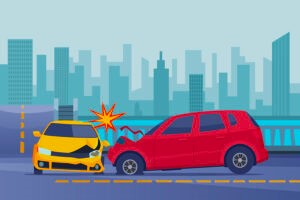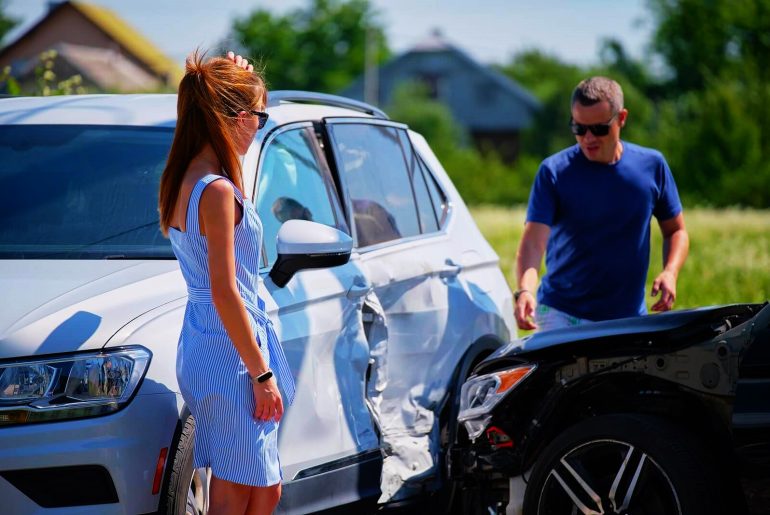Typically, in a Sideswipe Car Accidents, the driver who strays from their lane bears the responsibility. However, if you were pushed out of your lane by another vehicle, that driver could be liable as well. Should the responsible drivers leave the scene, your own insurance may provide coverage for the incident.
What is a sideswipe collision?
A sideswipe collision occurs when the sides of two parallel-moving vehicles make contact with each other. This type of accident typically happens when one vehicle unintentionally drifts out of its lane and into the lane of another vehicle traveling in the same direction, though it can also occur between vehicles moving in opposite directions. Sideswipe collisions can lead to significant vehicle damage and loss of control, potentially resulting in further accidents. Despite sometimes seeming minor compared to head-on or rear-end collisions, the side impact and the potential for subsequent loss of control make sideswipe accidents particularly dangerous, especially on multi-lane roads and highways where high speeds exacerbate the risks.
What are some common injuries from these accidents?
Sideswipe accidents, while often underestimated, can lead to a range of serious injuries or even fatalities. Common injuries from such collisions include:
- Traumatic Brain Injuries (TBIs): These can range from mild concussions to severe brain damage.
- Spinal Cord Injuries: Such injuries can lead to partial or complete paralysis.
- Neck Injuries: Including whiplash, which is common in car accidents due to the sudden jerking of the head.
- Head Injuries: Beyond TBIs, these can include cuts, abrasions, or fractures to the skull.
- Severe Internal Injuries: Damage to internal organs or internal bleeding can be life-threatening.
Less severe, yet still impactful injuries can also occur, such as:
- Broken Bones: The force of impact can easily break or fracture bones.
- Nerve Damage: This can result in loss of sensation or motor function in certain areas of the body.
- Severe Lacerations: Deep cuts that may require surgical intervention to heal.
- Road Rash: Skin abrasions resulting from contact with the road surface.
- Whiplash: Specifically affecting the neck and back due to rapid back-and-forth movement.
- Serious Scrapes and Bruises: These can be painful and take time to heal.
Vehicle damage, typically on the side involved in the collision, is also a common outcome of sideswipe accidents. If you’re not at fault, you may be entitled to compensation for property damage, medical expenses, and pain and suffering incurred due to the accident. Consulting with a personal injury attorney can be a crucial step in securing the compensation you deserve, as they can guide you through the process of filing an injury claim and negotiating with insurance companies.
What are some common causes of sideswipe accidents?
Common causes of sideswipe accidents include:
- Driver Negligence: Lack of attention or carelessness while driving.
- Distracted Driving: Engaging in activities that divert attention from driving, like texting.
- Driver Fatigue: Reduced alertness and reaction time due to tiredness.
- Drunk Driving: Impaired judgment and motor skills from alcohol consumption.
- Avoiding Road Hazards: Swerving to dodge obstacles and ending up in another lane.
- Road Rage: Aggressive driving behaviors leading to reckless lane changes.
- Converging into the Same Lane: Miscommunication or lack of awareness causing multiple drivers to merge into a lane simultaneously.
- Unsafe Lane Changes or Merges: Not checking blind spots or signaling can lead to unintended lane intrusions.
The specific cause of a sideswipe accident significantly influences who is deemed at fault.

What if I was partially to blame for the crash?
If you’re found partially at fault for a crash, the impact on your ability to recover compensation depends on the laws of the state where the accident happened. States follow one of three systems regarding shared fault in personal injury cases:
- Pure Comparative Negligence: Your compensation is decreased in proportion to your share of the fault. For instance, if you’re found to be 30% responsible for the accident, your recoverable damages would be reduced by 30%.
- Modified Comparative Negligence: Like pure comparative negligence, your compensation is reduced by your fault percentage. However, if you are found to be more than 50% (or, in some states, 51%) at fault, you are completely barred from receiving any compensation.
- Contributory Negligence: Under this strict rule, if you are found to have any degree of fault in the accident, you cannot recover damages. Only a few jurisdictions still follow this rule.
These fault determination rules are crucial not just in trials but also in shaping the settlement negotiations, as they provide a legal framework for assessing how compensation may be adjusted based on the involved parties’ degrees of fault.
What should I do after a sideswipe car accident?
After a sideswipe car accident, taking the right steps is crucial for your safety, legal protection, and the potential for a personal injury claim. Here’s what you should do:
- Stay at the Scene: Leaving can result in hit-and-run charges. Ensure you’re safely off the road but close to the accident site.
- Call the Police: A police report is essential for documenting the accident, and it’s often required for insurance claims.
- Document the Accident: Take photos of the accident scene, vehicle damages, and any relevant road signs or markings. This evidence can be vital later on.
- Exchange Information: Get the names, contact information, and insurance details of the other driver(s) involved, as well as contact details for any witnesses.
- Seek Medical Attention: Injuries from car accidents can be latent. Getting a medical evaluation immediately can identify hidden injuries and link them to the accident.
- Contact a Personal Injury Attorney: An attorney can guide you through the process of filing a claim, dealing with insurance companies, and ensuring you receive fair compensation for your damages and injuries.
Following these steps can help protect your rights and provide a solid foundation for any necessary legal action following a sideswipe accident.
How can a car accident lawyer help me?
A car accident lawyer can be invaluable after a sideswipe accident, providing expertise and support through several crucial steps to ensure you receive fair compensation for your losses.
- Navigating Insurance Claims: They guide you through the process of filing a claim, whether it’s against the at-fault driver’s insurer or your own, particularly if the accident involves an uninsured motorist or falls under no-fault insurance rules.
- Assessing Settlement Offers: Insurers often propose initial settlements that are less than what you may be entitled to. Your lawyer can evaluate these offers, ensuring you understand your case’s worth and helping you avoid quick settlements that undercut your true damages.
- Negotiating with Insurers: Armed with an understanding of your case’s value, your attorney can negotiate with insurance companies on your behalf, aiming for a settlement that adequately covers your losses.
- Filing a Lawsuit: If negotiations don’t result in a fair offer, your lawyer can file a personal injury lawsuit to formally seek the compensation you deserve, a step that often reignites settlement discussions.
- Conducting an Independent Investigation: To strengthen your case, your attorney will gather evidence, reconstruct the accident scene, and compile documentation that supports your claim, providing a solid basis for settlement negotiations or trial.
- Representing You at Trial: Should your case go to trial, your lawyer will present your evidence compellingly, aiming to secure a verdict in your favor that accurately reflects the compensation you deserve for your losses.
- Filing Appeals: If the trial outcome is unsatisfactory due to legal errors, your attorney can appeal the decision, seeking a more favorable outcome.
- Advocating in Fatal Accident Cases: In tragic circumstances where the accident results in a fatality, a car accident lawyer can represent the victim’s family in a wrongful death lawsuit, helping them seek justice and compensation for their profound loss.
Throughout this process, your lawyer serves as your advocate, advisor, and ally, striving to secure the best possible outcome for you and your loved ones.




